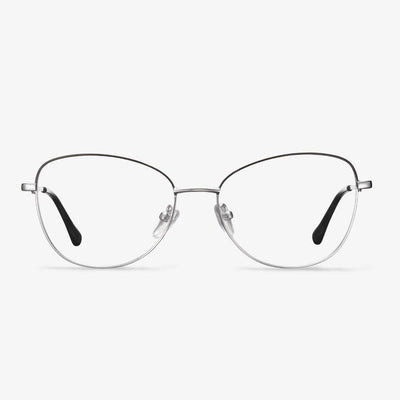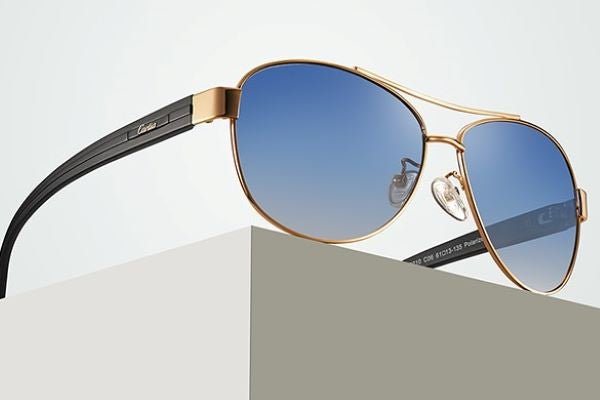How to choose rectangular glasses?
Look at the facial features in the aspect of proportion. If your features are delicate, which makes you look petite, you can choose some wider glasses so that you will increase your mental outlook, making your features prominent. On the other hand, if your features look solid and take up a large space of your face, go for narrower frames, because wider frames will make you look tired and add weight to your head.
Semi-rimless glasses
With a half-frame design, the retro round glasses can be paired with a very thin metal frame, indicating the literary and elegant temperament. The frame with only the upper part of the lenses circle covering the lens integrates lightness and steadiness, highlighting the sense of fashion, not only shows the wisdom of business elites but the natural and free affinity. They are not heavy and relatively firm. It is suitable for different kinds of occasions. It can be used for business occasions, leisure occasions, and parties. It is stylish and composed, reflecting the quality of life.
The design evolution of progressive lenses
Spherical and aspheric designs
The design of the front surface of the far-use area of the early progressive lens is similar to that of the ordinary spherical single vision lenses, so it is called a spherical progressive lens. Since 1974, the front surface of the far-use region of the lens is designed to be aspheric by designers, which not only reduces the peripheral aberration but makes the lens thinner, lighter, and less powerful.
Hard and soft design
For hard design, the channel is short, and the gradient is large. The near-use area position is high. The effective visual area of remote and near-use areas was larger. Peripheral astigmatism is relatively concentrated. Because surrounding astigmatism increases rapidly and the distribution is dense, the curve effect is more obvious. The gradient area is narrow. It is more difficult and takes longer for wearers to adapt.
Lenses with soft designs have slower gradients, longer gradients, and wider gradients. The angle of rotation of the eye from the far area to the near area is greater. It's easier to get used to. Compared with the hard design, the effective visual area of the far and near use areas is smaller, and the location of the near use area is lower.
Single, diverse, and individualized design
Initially, the progressive lenses used a single design, in which each basic curve was scaled equally and a luminosity combination was added within the range of its semi-finished lens blanks. The steepest base curve uses the same lens design as the flattest base curve. Lenses designers quickly realized that the overall performance of the lens could be improved by microcustomizing the lens design, leading to progressive lenses with multiple designs. This kind of design is called diverse design. By the mid-1990s, there was the emergence of individualized lens designs. In addition to using different gradients, these first individualized lens designs used steeper baseline curves with a slightly larger approach area to compensate for increased magnification and reduced field of view.
Symmetrical and asymmetric design
There is no difference between the left and right eyes in the symmetrical design of progressive lenses. As the eyes turn inward when they see near objects, the gradual gradient area gradually tilts to the nasal side from top to bottom, so the left/right progressive lenses should be rotated clockwise/counterclockwise respectively during processing. An asymptotic lens with left and right eye divisions is called an asymmetric design. The gradient is gradually and moderately inclined to the nasal side from top to bottom. The refractive force, astigmatism, and vertical prism of the two sides of the left and right gradient of the asymmetric design lenses are basically similar. At the same time, considering the characteristics of eye movement parameters in binocular vision, the peripheral aberrations of the corresponding positions of the left and right lenses were appropriately balanced to improve the visual effect of the wearer.
The length of the temple is important.
The glasses should fit snugly over and behind the ears. If they clip behind the ear, mostly, the arm might be too short. The arms of your glasses should be straight back toward your ears, touching only the side of your head, just in front of your ears. If the temple bends too soon, it pushes the glasses under the nose, putting too much pressure on the bridge of the nose and causing a headache.
How to test a blue-light lens?
Blue-light-blocking lenses are now focused on refractive indices of 1.56 and 1.60. If you buy lenses that are not of either refractive index, be wary. Of course, with the development of technology, now some brands have produced 1.71 refractive indexes blue-light-blocking lenses, suitable for people with high myopia to wear. The true lens package should at least have the product name, refractive index, dispersion coefficient, transmittance, color, SPH, CYL, and other indicators. These indicators are perfect, can be treated as the reference basis of the formal product. In addition, you can go to a professional optical shop or testing institutions for testing.
The Optical Center of A Lens
When wearing glasses, try to look through the optical center of the lens. This needs the cooperation of the neck, you can slightly lower the head when looking at the computer, to adjust the line of sight. The Center of optical glasses is divided into two kinds: 1 mm up myopic lens center is the most proper, of course, more than 2-3. And the most important thing is that the lens pupil high (about the two-lens optical center of the high and low) must be proper (that is, the right of the lens optical center is 1 mm, the left must be 1 mm. 2-3 mm is the same, what is the height of the pupil on the right side must be the same on the left side. The optical center of the presbyopic lens is 1 mm, the most proper.
How Are Glasses Made?
In this section, we will show you how glasses are made. Here are a few steps.
- Eyeglasses lenses are first made by an optician reviewing your prescription and taking a lens bank that closest matches your prescription.
- The optician puts the lens bank into a grinding machine and grinds it into a shape that matches your prescription even closer.
- Then the glasses lenses are edged and cut into a shape that fits the frame you chose.
- Last, put the cut lenses into a solution so as to protect them from scratches, then give them a tint and more.
After all steps are finished, the glasses are made successfully.


































